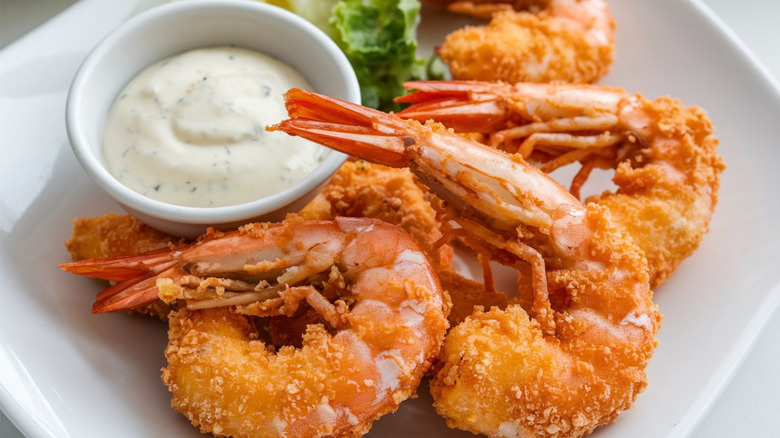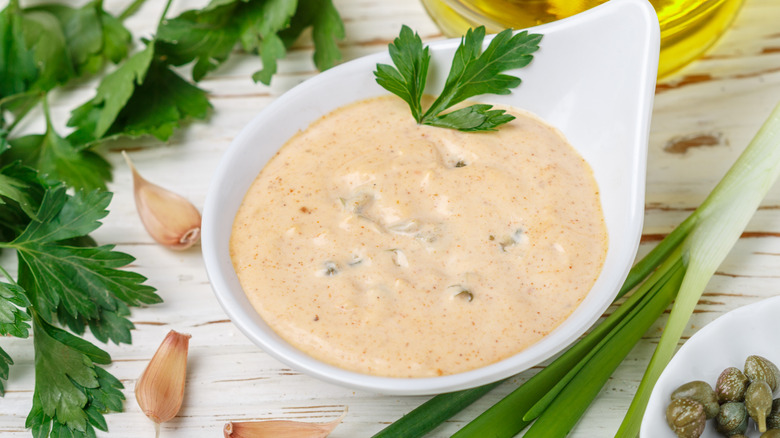Do You Know The Difference Between Tartar Sauce And Remoulade?
Just as an order of french fries is almost always served with a side of ketchup and tortilla chips automatically come with a dish of salsa, so fried seafood is usually accompanied by a bit of rich, cold, creamy sauce. For the most part, it's tartar sauce, but on occasion, it's remoulade. The two can often be used interchangeably, and they both taste great with fried fish and shellfish, but tartar and remoulade sauce aren't carbon copies of each other.
While they share the same core ingredients, a basic tartar sauce can come together with just mayonnaise and sweet pickle relish, although many versions include an acid like lemon juice or maybe a squirt of mustard. Sometimes, fresh herbs and a bit of onion make appearances. When it comes to remoulade sauce, herbs are about as necessary an ingredient as the mayonnaise itself, and things like vinegar and hot sauces are often present, making it much less sweet than tartar sauce. And unlike tartar sauce, there are several versions of remoulade sauce, from the classic Louisiana-style that's popular on po'boy sandwiches to a version that's widely enjoyed in Scandinavia.
Tartar sauce
History first records the mention of "tartar sauce" in 19th-century French cookbooks, where it was a suggested condiment for beef tartare. Interesting, a raw egg yolk (an ingredient in mayo) is often served with beef tartare today ... is that a possible nod to its mayo-centric origins? The word "tartar" could have come from a group of people called Tartars, who came from Western Russia and Turkey, and whose diet allegedly included shredded meat. Alternatively, tartar sauce could have ties to "tarator sauce," a Middle Eastern condiment made of ground nuts or tahini that is served with meat or fish.
Tartar sauce as we know it today is largely based on a version that Hellman's developed and mass produced in the 1920s. Today, the company's pre-made sauce is made with water, sweet pickle relish, canola oil, corn starch, sugar, eggs, vinegar, salt, potato starch, lemon juice concentrate, sorbic acid and calcium disodium edta, natural flavor, and paprika extract. For a homemade version, Hellman's recommends combining mayonnaise, lemon zest, lemon juice, horseradish, sweet pickle relish, and capers. But the sauce is highly customizable as well, with many recipes adding various spices, different types of vinegar, and flavored mayonnaise. Tartar sauce is great with fried fish, shellfish, calamari, crab cakes, and french fries, but you could also put it on burgers and sandwiches.
Remoulade sauce
Remoulade sauce also has historic origins in France, and specifically in a northern region called Picardy. According to an 18th-century cookbook, a recipe for remoulade described a condiment based in mayonnaise but flavored with mustard. This kind of sauce also traditionally contains horseradish, and in fact, the Picardy population referred to the potent root as "remolat" or "ramolas." This type of traditional French remoulade also contains herbs like chervil, tarragon, and parsley, along with capers, chopped cornichons, and sometimes anchovies.
Louisiana-style remoulade is widely served with New Orleans seafood dishes, like shrimp or oyster po'boys. It is flavored with, among other ingredients, Creole mustard (a spicy, Southern mustard that's great on hot dogs), green onion, celery, parsley, lemon juice, cayenne pepper, and hot sauce. Naturally perfect with fried seafood, both French- and Louisiana-style remoulades are also excellent with fried chicken, fried green tomatoes, and fried dill pickles. For authenticity, make this sauce with Blue Plate mayonnaise, the best mayo you don't know about.
In Denmark, there is a different kind of remoulade that is often served on open-faced sandwiches called smorrebrod. Also tasty on french fries, Danish remoulade is flavored with cauliflower, cabbage, gherkins, onions, and cucumber pickles. It's also colored with turmeric. Finally, in Mississippi, there is comeback sauce, which is basically a Louisiana-style remoulade that substitutes ketchup for hot sauce, making the condiment less spicy and more sweet. Just like other remoulades, it is used as a dipping sauce for seafood, but is also delicious as a dressing.


